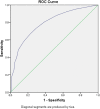Comparing SPEED and OSDI Questionnaires in a Non-Clinical Sample
- PMID: 34703203
- PMCID: PMC8541762
- DOI: 10.2147/OPTH.S332565
Comparing SPEED and OSDI Questionnaires in a Non-Clinical Sample
Abstract
Purpose: To compare the performance of OSDI and SPEED questionnaires in a non-clinical sample in Pakistan.
Methods: SPEED and OSDI questionnaires were simultaneously administered to a sample of 600 participants in Pakistan with an average age of 31.0 ± 10.1 years.
Results: Mean SPEED scores were calculated according to the OSDI categories and were found to be 3.33 ± 3.44, 5.45 ± 3.77, 7.86 ± 4.33, and 9.39 ± 4.56 for the normal, mild, moderate, and severe groups, respectively. Using Cronbach's alpha, the total OSDI and SPEED scores were calculated to be 0.924 and 0.879, respectively. A receiver operating curve was plotted, and the area under the curve (AUC) was estimated to be 0.791. Using this curve, the cutoff score for the SPEED questionnaire was found to be 4.00 (P < 0.001).
Conclusion: The SPEED questionnaire can be used as an effective alternative to the OSDI.
Keywords: Cornea; aqueous deficiency; dry eye disease; dry eye syndrome; refractive surgery.
© 2021 Hashmani et al.
Conflict of interest statement
The authors report no conflicts of interest in this work.
Figures
References
-
- Dell SJ, Gaster RN, Barbarino SC, Cunningham DN. Prospective evaluation of intense pulsed light and meibomian gland expression efficacy on relieving signs and symptoms of dry eye disease due to meibomian gland dysfunction. Clin Ophthalmol. 2017;11:817–827. doi:10.2147/OPTH.S130706 - DOI - PMC - PubMed
LinkOut - more resources
Full Text Sources



